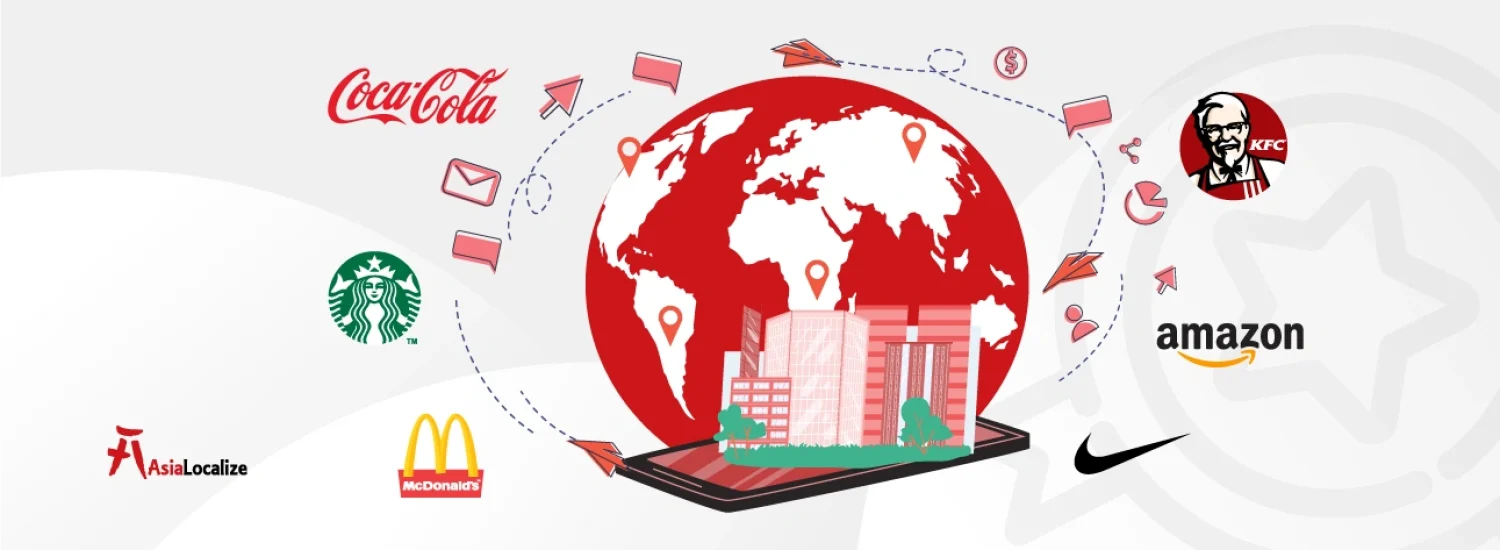72% of consumers go to localized products/services. If they can’t relate, they won’t purchase, as easy as it sounds. However, localization is much more than translation; it’s a comprehensive process that transforms a product/service to feel relevant and natural to a foreign audience.
Your brand might work seamlessly with your local audience. But how will it resonate with a foreign market with different cultures and tongues? Brand localization is your winning horse in global markets.
Let’s take a closer look at the vital process of brand adaptation for global markets and help you play it the right way for maximum impact and success.
What’s Brand Localization?
Brand localization is the strategic adaptation of a brand’s identity, messaging, and offerings to align with the cultural, linguistic, and market-specific preferences of a target region while maintaining its core essence and attributes. It goes beyond translation, incorporating local values, aesthetics, and behaviors to resonate authentically.
Brand localization ensures that your brand feels authentic and relevant to local audiences, whether through retail brand localization or mobile app localization for brands.
For example, Coca-Cola masterfully embraces regional brand strategies, such as incorporating regional festivals in its campaigns or crafting flavors suited to local palates. Their 2024 Christmas ad, a dazzling celebration of holiday spirit, has become a cherished tradition, earning a stellar 5.9-star rating in industry testing. Research reveals that 29% of viewers feel a warm wave of nostalgia, proving Coca-Cola’s knack for sparking emotional resonance and exceptional engagement across diverse audiences.
The Key Benefits of Brand Localization
By aligning with local preferences, brands can forge deeper connections, drive growth, and outshine competitors.
Boost Customer Engagement
Cross-cultural brand adaptation creates an emotional bond by reflecting the cultural values, traditions, and preferences of target audiences. By incorporating local festivals, dialects, or humor, brands make consumers feel seen and understood, leading to higher engagement metrics like click-through rates and social media interactions.
A 2024 report by DeepL found that 96% of businesses saw a positive ROI from localization efforts, with 65% reporting an ROI of 3x or greater.
Enhance Brand Loyalty
Culturally sensitive branding builds trust by demonstrating respect for local customs and values, fostering long-term customer relationships. When brands adapt messaging to align with local norms, such as KFC offering vegetarian options in India or using regional spices in the Middle East, they signal a commitment to their audience.
This trust translates into loyalty, as 64% of consumers maintain relationships with brands due to shared values, according to a 2023 study.
Increase Sales
A 2021 McKinsey report notes that personalization, including localization, can deliver a 1-2% lift in total sales for retailers, with even higher gains for non-grocery sectors.
E-commerce brand localization drives conversions by tailoring the shopping experience to local preferences, from language and currency to culturally relevant visuals. For example, Amazon’s Rural India strategy localized its platform to include regional languages and payment methods, boosting sales in underserved markets.
Gain a Competitive Edge
76% of consumers prefer products with information in their native language, giving localized brands a distinct advantage.
Localized branding sets brands apart in crowded markets by showcasing cultural fluency and relevance. Brands like McDonald’s, which balances global consistency with local menu items like the McSpicy Paneer in India, differentiate themselves from competitors who rely on standardized approaches.
What Makes a Brand Localization Strategy Effective?
An effective brand localization strategy transforms a global brand into a local favorite by deeply understanding and embracing the cultural, emotional, and behavioral nuances of target markets. It balances authenticity with consistency, ensuring the brand resonates locally while staying true to its core identity.
Local Market Research for Branding
The foundation of impactful localization lies in thoroughly understanding local consumer behavior, purchasing patterns, and cultural preferences. This means diving into what drives decisions—whether it’s price sensitivity, brand trust, or cultural rituals—and tailoring strategies accordingly.
For example, when designing logos, brands like Nike research color symbolism (e.g., red for luck in China, white for purity in Japan) to ensure visual elements resonate.
Cultural Adaptation with Sensitivity
Effective localization incorporates local traditions, values, and sensibilities into messaging, imagery, and campaigns. This goes beyond surface-level changes to create authentic connections—think Starbucks offering sakura-flavored drinks during Japan’s cherry blossom season or Coca-Cola celebrating Diwali in India with vibrant, family-centric ads.
Tailored Regional Branding Strategies
A winning strategy customizes marketing for specific regions while preserving the brand’s global essence. This balance ensures campaigns feel locally relevant without diluting brand identity.
For instance, McDonald’s maintains its iconic golden arches worldwide but offers regionally inspired menus, like Chicken Maharaja Mac (sold only in India).
Multilingual Messaging with Emotional Depth
Exceptional localization transcends literal translations, capturing the tone, idioms, and emotional nuances that speak to local hearts. This means crafting messages that feel native, whether it’s using colloquial humor in Australia or poetic storytelling in France.
For example, Apple’s Chinese New Year campaigns use Mandarin idioms to evoke family and tradition, striking an emotional chord.
| Learn how Marketing Translation Services can help you craft culturally relevant messaging for global audiences. |
How to Simplify Brand Localization with the Right Tools and Strategies
Brand localization can be complex, but the right tools and strategies can streamline the process, ensuring efficiency, consistency, and cultural resonance across global markets.
AI-Driven Brand Localization Tools
A 2024 report by Slator notes that 78% of brands using AI-driven localization tools report a 30% reduction in project timelines, making them essential for efficient global expansion.
Artificial intelligence revolutionizes localization by automating workflows, enhancing consistency, and reducing time-to-market.
Localization Automation for Scalability
A study found that brands using localization automation achieved 25% faster market entry, proving its value in balancing speed and accuracy.
Automation streamlines repetitive tasks, allowing brands to scale localization efforts without sacrificing quality.
Translation Software for Seamless Management
Translation Management Systems (TMS) are pivotal for orchestrating large-scale localization projects. These platforms centralize content, manage workflows, and enable collaboration among translators, marketers, and developers. Actually, brands leveraging TMS reported a 40% decrease in localization costs.
Editing and Proofreading for Cultural Precision
Even with advanced tools, human oversight is crucial to ensure localized content is culturally and linguistically flawless. Professional editing and proofreading catch subtle errors, refine tone, and verify cultural appropriateness—preventing missteps like Pepsi’s infamous “Come alive with the Pepsi Generation” campaign, mistranslated in China as “Pepsi brings your ancestors back from the grave.”
| Our Editing and Proofreading services ensure your localized content is error-free and impactful. |
Common Obstacles in Brand Localization—and How to Solve Them
Brand localization is a powerful tool for global success, but it comes with challenges that can derail even the most well-intentioned efforts.
Cultural Missteps
Misinterpreting cultural nuances can lead to offensive or ineffective campaigns, alienating audiences. That’s why it’s integral to engage local experts—cultural consultants, native translators, or focus groups—to review content for appropriateness.
Maintaining Brand Consistency
Adapting to local markets while preserving a brand’s global identity is a delicate balance. Over-localization risks diluting the brand, while under-localization feels generic.
That’s why it’s imperative to establish clear brand guidelines that define core elements (e.g., logo, tone, values) while allowing flexibility for local adaptations.
Time and Resource Constraints
Localization projects often demand significant time, budget, and expertise, straining resources, especially for smaller brands.
So, as a solution, go for a technology-powered human localization solution, integrating AI-driven localization tools into your strategy to automate workflows, reduce manual effort, and accelerate timelines.
| Explore how Big Brands Pull It Off in Japan with effective website localization strategies. |
Breaking the language and cultural barriers isn’t optional in the international market; it’s integral for guaranteed success. However, brand localization, while essential, is a complex journey that demands precision, cultural insight, and strategic expertise. Partnering with a seasoned localization company like AsiaLocalize, with years of proven experience and thousands of successful projects, ensures your brand resonates authentically across borders.
| Infuse Your Brand with Local Flavor—Connect Globally, Thrive Locally! Contact Our Localization Experts for a Free Consultation |







